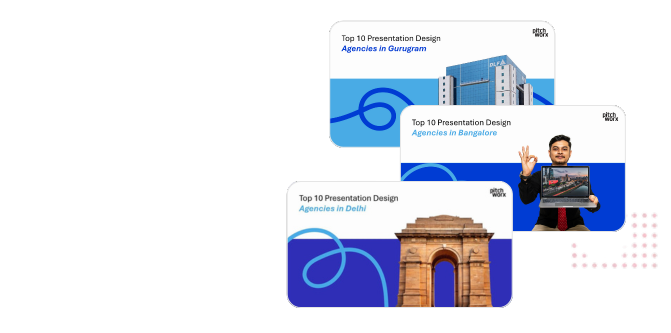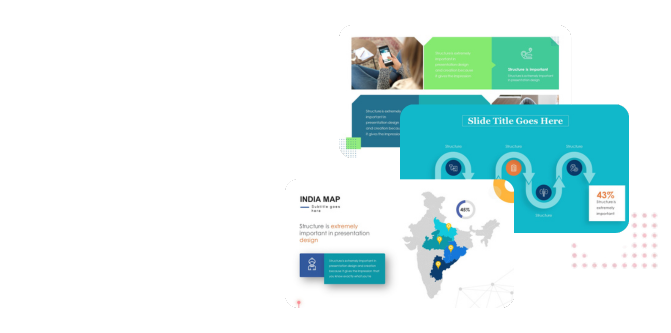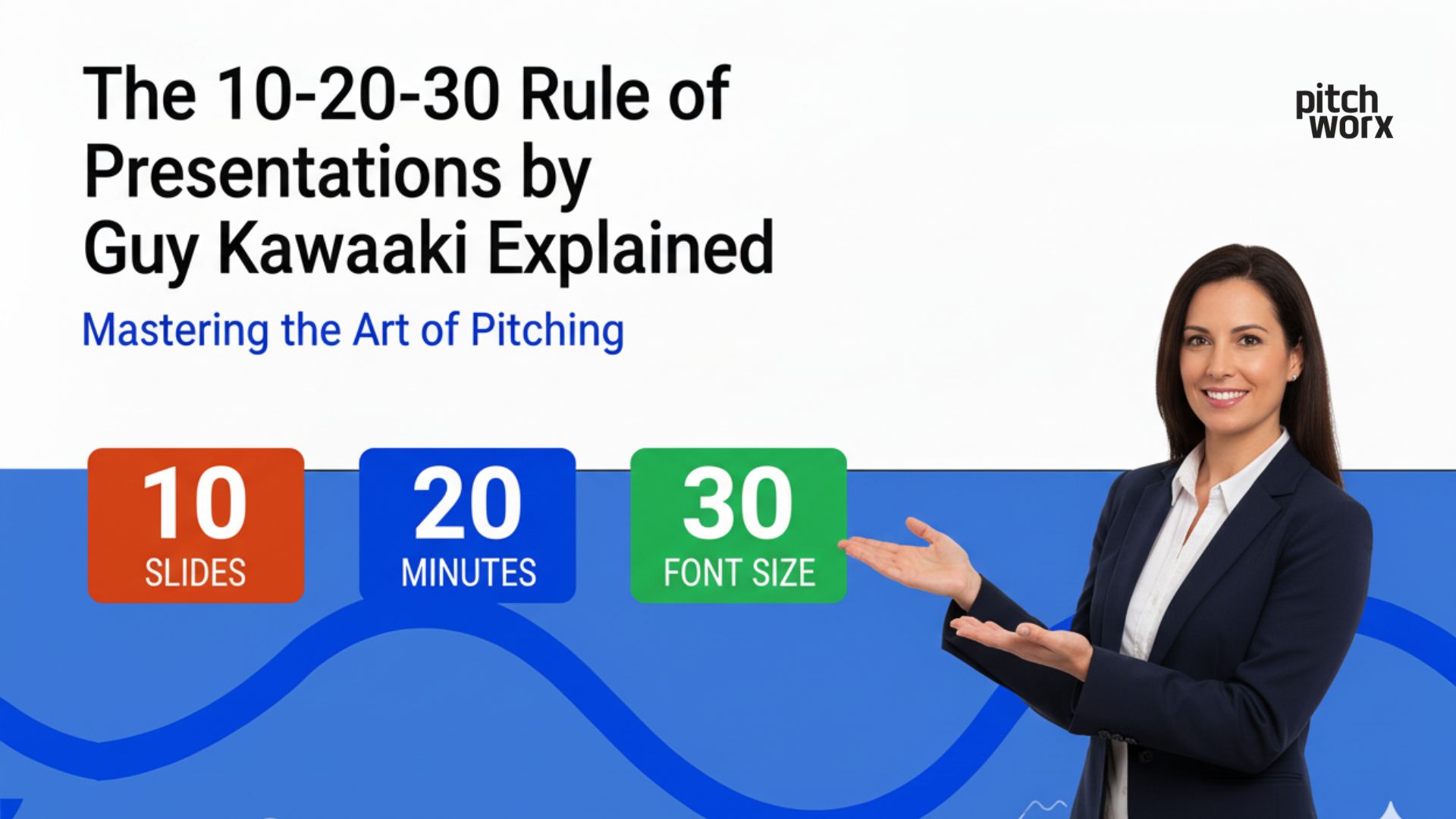Published: November 04, 2025 | Reading Time: 13 minutes | Author: PitchWorx Design Team
Table of Contents
- Introduction
- What is the 10-20-30 Rule?
- Breaking Down the Rule: The Technical Deep Dive
- The Growth Differential: Normal Pitch Deck vs. 10-20-30 Rule
- Industry-Specific Applications Across USA Markets
- Creative Hacks for the Modern USA Startup
- Future Trends: The 10-20-30 Rule in 2025 and Beyond
- Working with Presentation Design Agencies: When and Why
- Keyword-Optimized Checklist for USA Startups
- Conclusion: Why This Rule Still Dominates in 2025
Introduction
In the high-stakes world of American entrepreneurship, where over 1.4 million startups launch annually, your pitch deck can make or break your venture capital dreams. Enter Guy Kawasaki’s legendary 10-20-30 rule—a presentation framework that’s revolutionized how founders, executives, and entrepreneurs communicate their vision to investors across Silicon Valley, New York, Boston, and beyond.
As Apple’s former Chief Evangelist and a venture capitalist who’s reviewed thousands of pitch decks, Kawasaki identified a critical pattern: most presentations fail not because of bad ideas, but because of poor execution. His 10-20-30 rule emerged from witnessing countless entrepreneurs lose funding opportunities due to overwhelming, confusing, or poorly designed presentations.
What is the 10-20-30 Rule?
The 10-20-30 rule is elegantly simple:
- 10 slides maximum
- 20 minutes presentation time
- 30-point font minimum
This isn’t arbitrary. It’s based on psychological research about attention spans, cognitive load, and the way venture capitalists process information during back-to-back pitch sessions.
Breaking Down the Rule: The Technical Deep Dive
The “10”: Why Ten Slides is the Magic Number
According to cognitive psychology research, the human brain can effectively process 7-10 distinct chunks of information in a single sitting. The essential 10 slides for USA startups include Title, Problem, Solution, Market Opportunity, Business Model, Competition, Marketing & Sales, Team, Financials, and the Ask.
The “20”: Twenty Minutes of Pure Value
Most VC meetings are scheduled for an hour, but you realistically have 40 minutes. Kawasaki’s 20-minute rule leaves 20 minutes for Q&A—the most critical part where investors dig deep.
The “30”: Font Size That Commands Respect
The 30-point font rule isn’t about aesthetics—it’s about accessibility and clarity. Large fonts force you to distill ideas, convey confidence, and ensure readability in any presentation environment.
The Growth Differential: Normal Pitch Deck vs. 10-20-30 Rule
Graph 1: Investor Engagement Comparison
Research shows that 10-20-30 compliant decks achieve a 68% engagement rate and a 34% conversion to second meetings, more than double the success rate of traditional decks.
Graph 2: Funding Success Correlation
Data from Crunchbase shows startups following 10-20-30 principles raise an average of $2.8M in seed funding, compared to $1.6M for those with lengthy decks.
Industry-Specific Applications Across USA Markets
SaaS Startups: Focus on screen recordings, key metrics (MRR, CAC, LTV), and integrations with popular US enterprise tools.
FinTech Startups: Dedicate slides to compliance (SEC, FINRA), security architecture, and partnerships with major US banks.
HealthTech & BioTech: Use clear visual charts for clinical data, regulatory timelines (FDA pathway), and reimbursement strategies.
Creative Hacks for the Modern USA Startup
- The “Traction Teaser” Opening: Start with your most impressive metric in 72pt font to create instant credibility.
- Interactive Data Visualization: Use embedded interactive charts to show month-over-month growth or cohort analysis.
- The “Competitive Matrix Pivot”: Use a dynamic positioning map to visually communicate your superiority.
- Video Social Proof: Embed 15-second testimonial clips from US customers to create an emotional connection.
Future Trends: The 10-20-30 Rule in 2025 and Beyond
The future of pitch decks includes AI-enhanced presentations, Virtual Reality pitch decks, and a greater emphasis on sustainability metrics, all of which benefit from the 10-20-30 rule’s principles of clarity and focus.
Working with Presentation Design Agencies: When and Why
72% of successfully funded US startups work with professional designers. It’s a worthy investment when raising $2M+, dealing with complex technical products, or preparing for high-stakes roadshows. A $5,000 investment in a design agency can yield a 4,000% ROI if it helps secure funding.
Keyword-Optimized Checklist for USA Startups
- 10 slides maximum
- 20-minute rehearsed delivery
- 30pt minimum font
- US market data and competitor analysis
- Clear financial ask
Conclusion: Why This Rule Still Dominates in 2025
In an era of information overload, the 10-20-30 rule isn’t just relevant—it’s essential. It respects three fundamental truths: attention is scarce, simplicity sells, and clarity wins. The startups that master this rule consistently outperform competitors in fundraising, partnerships, and market positioning. The 10-20-30 rule isn’t a constraint—it’s a competitive advantage in the world’s most dynamic startup ecosystem.










